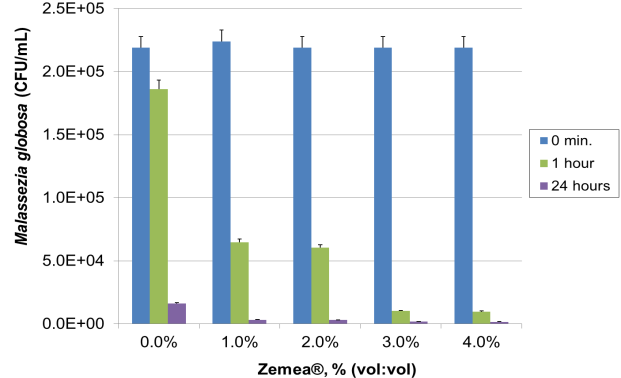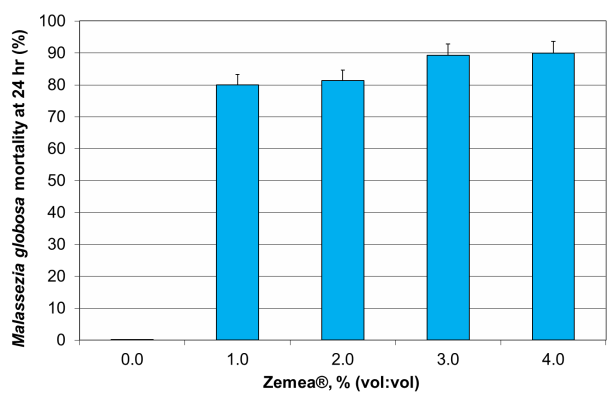Introduction
The potential for boosting zinc pyrithione (ZPT) efficacy by using Zemea® propanediol in a generic anti-dandruff shampoo formulation was evaluated in this study. A time-dependent, dose-response relationship was observed between the mortality of Malassezia globosa, a microorganism associated with human dandruff, and Zemea® concentration over a range of 0–4%.
In this study, we evaluated the combined effect of Zemea® propanediol and zinc pyrithione on mortality of M. globosa, a microorganism associated with human dandruff. The concentration of Zemea® propanediol that was tested in this study was approximately 50% under the Minimum Fungicidal Concentration, which permitted insight into interactions of Zemea® propanediol and zinc pyrithione. The results indicate that Zemea® propanediol significantly enhances the effect of zinc pyrithione, and that efficacy of hair care formulations intended for the control of dandruff can be improved by incorporation of Zemea® propanediol.
Background
Previously we completed two studies and reported the preservative boosting efficacy of Zemea® propanediol in a skin care formulation. The preservatives tested included four phenoxyethanol-based and three natural-based systems to represent combinations commonly used for their effectiveness to protect cosmetic and personal care products that were susceptible to microbial growth and contamination. The preservatives were tested at one-half their recommended use level using CTFA Microbiology Guidelines. In addition to these studies the bactericidal and fungicidal properties of Zemea® propanediol were evaluated. The test results concluded that the bactericidal and fungicidal performance for Zemea® was comparable to PG and better than BG, both as neat solutions and as an ingredient in the emulsion.
Experimental Design
A. Formulation
The test solutions were manufactured and supplied by Bria Research in Libertyville, IL, USA. All formulations contained 1,2% zinc pyrithione (2.5 wt.% solution x 48 wt.% ZPT = 1,2% zinc pyrithione). Zemea® propanediol was added at the 0,1,2,3,and 4% levels.
Table 1. Formulation used in test solution
|
Ingredient |
INCI Name |
Weight, % |
|---|---|---|
|
Water |
Water |
qs to 100% |
|
Zemea® Propanediol |
Propanediol |
0 to 4.0 |
|
Carbopol Aqua SF-1 |
Acrylate Copolymer |
6.00 |
|
Sodium Hydroxide 30% |
Sodium Hydroxide |
0.50 |
|
Steol CS230 |
Sodium Laureth Sulfate |
50.00 |
|
Cocamidopropyl Betaine |
Cocamidopropyl Betaine |
10.00 |
|
Mackamide CMA |
Cocamide MEA |
2.00 |
|
Sodium Chloride |
Sodium Chloride |
0.50 |
|
Zinc Omadine FPS 48% |
Zinc Pyrithione |
2.50 |
|
Na4EDTA, Crystals |
Tetrasodium EDTA |
0.02 |
|
Mackstat DM |
DMDM Hydantoin |
0.75 |
|
Fragrance |
Fragrance |
0.50 |
|
Citric Acid |
Citric Acid |
to pH 5.5 |
B. Organism and Test Methods
The organism was prepared and the testing was conducted by Pharmaceutical Laboratories and Consultants Inc. M. globosa (ATCC MYA-4612) was grown on Sabourauds dextrose medium with lecithin and polysorbate 80 as neutralizers for 7 days at 20 to 25C. After 7 days, the organism was harvested by scraping and suspending the organism in Butterfields buffer. This suspension was serially diluted and plated to determine initial colony-forming units (CFU).
Recovery control of the organism was performed by taking an uninoculated aliquot of the 4% Zemea® propanediol and serially diluting to 10–4 and subsequently inoculating each dilution with a 10–4 suspension of organism, mixing and plating. Exactly 15 grams of each test solution was transferred without dilution into 4 falcon tubes. Each tube was inoculated with 0.1 mL of M. globosa and the tube was mixed by inversion.
After inoculation, a 1 mL aliquot was removed from the tube at the specified time (0, 10 min., 1 hr., and 24 hr.) serially diluted, and then transferred to petri plate containing the modified Sabourauds media as described above, with 2% agar.
All testing took place at room temperature. Incubation was 20 to 25 C for 7 calendar days. Each test was performed in triplicate and the mean for the population was reported.
C. Stock Solution, Recovery Test, and Dilution
All CFU reported as log 10 CFU/mL. Initial plating indicated that the stock solution was approximately 2 x 107 CFU/mL. The 4% Zemea® propanediol was serially diluted to 10–4 and inoculated with a 10–4 dilution of initial suspension using 0.1 mL (Table 2). This quality control verification of M. globosa recovery at various dilution levels used in this study verified that the dilution process did not significantly influence viability counts. This was reported by Pharmaceutical Laboratories and Consultants Inc.
Table 2. Recovery Test – Dilution of 4% Zemea®
|
4% Zemea® |
Recovered CFU/mL |
|---|---|
|
Undiluted |
2300±92 |
|
1:10 |
2270±91 |
|
1:100 |
2320±93 |
|
1:1,000 |
2340±94 |
|
1:10,000 |
2290±92 |
Results
Shown below is the observed time-dependent dose-response relationship between M. globosa mortality and Zemea® concentrations ranging from 0–4% (Table 3 and Figure 1). All CFU reported as log 10 CFU/mL. All test samples were inoculated with 0.1 mL of a 1:10 dilution of the stock solution.
Zemea® demonstrated synergistic effects with zinc pyrithione resulting in a 90% increase of Malassezia globosa mortality at a level of 4% Zemea® and 1,2% zinc pyrithione (Figure 2).
Table 3. Time Dependent Dose-Response Relationship – M. globosa mortality and Zemea® Concentration
|
% of Zemea® |
0 time |
10 min |
1 hour |
24 hours |
|---|---|---|---|---|
|
0% |
5.34±0.21 |
5.25±0.21 |
5.27±0.21 |
4.21±0.17 |
|
1% |
5.35±0.22 |
5.15±0.20 |
4.81±0.19 |
3.51±0.14 |
|
2% |
5.34±0.21 |
5.21±0.20 |
4.78±0.19 |
3.48±0.14 |
|
3% |
5.34±0.21 |
5.22±0.20 |
4.01±0.16 |
3.24±0.13 |
|
4% |
5.34±0.21 |
5.17±0.20 |
3.99±0.16 |
3.21±0.13 |
Figure 1. Time Dependent Dose-Response Relationship – M. globosa mortality and Zemea® Concentration

Figure 2. Mortality Rate at 24 Hours – M. globosa vs. Zemea® Concentration

Conclusion
- Zemea® propanediol may provide improved efficacy in anti-dandruff shampoos.
- With the addition of 1% Zemea® in combination with 1,2% zinc pyrithione, results indicate enhanced mortality of M. globosa over a control with no Zemea®.
- With the addition of 4% Zemea® in combination with 1,2% zinc pyrithione, mortality rate of M. globosa increased by 90%.
Summary
- The potential for Zemea® propanediol to boost zinc pyrithione efficacy when used in an anti-dandruff formula was studied.
- All solutions contained 1,2% zinc pyrithione. Zemea® propanediol was added at the 0,1,2,3,and 4% levels.
- Zemea® demonstrated synergistic effects with zinc pyrithione resulting in a 90% increase of Malassezia globosa mortality at a level of 4% Zemea® and 1,2% zinc pyrithione.
- The efficacy of hair care formulations intended for the control of dandruff can be improved by incorporation of Zemea® propanediol.
For additional information or samples, please contact: DuPont Tate & Lyle Bio Products Customer Service
Telephone: 1–866–404–7933
On the web: www.duponttateandlyle.com


